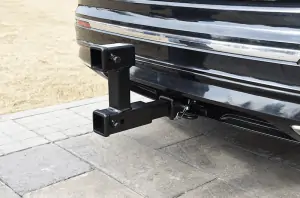We have all been in situations where we tried to carry heavy loads and ended up with strained muscles. Most even end up in the emergency room.
If you are one of them, then you must appreciate the invention of winches. From small loads to giant equipment, there is nothing these machines can’t carry for you.
However, winches were pretty simple devices back in the day. As jobs became heftier and more complicated, people felt the need for newer, more powerful machines.
Hence, all these different types of winches came into the picture.
In this article, we will go through some of the most common types of winches and focus on their benefits.
Common Parts of a Winch
The basic structure of almost all the different types of pulling devices has something in common.
Getting familiarized with the standard components will give you a heads up and a better understanding of the product and how they work.
Winch Drum
The drum is the most common component of any hoisting machine. A drum is a cylindrical rotating part on which the cable or rope feeds.
In the case of electrical hoists, the drum revolves around a motor and a drive train. You can change the drum’s direction to a vertical or horizontal position.
Tow Rope
A rope is the tow line that pulls or drags loads. It remains connected with the main machine; usually, it remains reeled onto the drum.
You can either use cable lines or synthetic ropes according to the type of job. The wires’ length and diameter depending on the design of the machine.
Motor
Many electrical and mechanical hoists come with a motor. The motor receives power from batteries to run. All electric motors feature two sets of coils.
The coils produce a magnetic field, which causes the drum to rotate when current flows through it. Furthermore, the engine gives power to the gear mechanism.
Fairlead
The fairlead is an essential part of a winch. It is useful mostly in cases when you need to pull the load at an angle.
The fairlead helps the tow line to roll into the spooling drum easily. It also prevents the tow line from damages by providing added rolling feature.
Lever
Most manual lifting devices come with a lever or a crank. A lever is just a simple handle that allows you to rotate the drum of the machine manually.
All you need to do is spin the lever up and down to pull or drop your load.
Different Types of Winches
We have picked some of the most common types of winches and explained their uses in detail.
Capstan Winch
A capstan winch pretty much does whatever a standard pulling device does for you. The only difference is in the engineering and operation.
Uses
This machine comes in different versions. But the most popular one is the portable capstan hoist. If you have any lightweight pulling job, this can be your first pick.
These types of pulling machines are a popular choice for mining, sailing, and construction works. You can find smaller versions for small-scale weight lifting activity too.
And you never know when a tree falls on your while driving. Keeping a portable capstan winch on your car can make you the hero of the day.
One good thing about this device is that it can go running for hours without a break. You do not need any cool-down period and get your job done fast.
Structure
Capstan winches have a cylindrical shaped drum that revolves on a spindle. Unlike other standard winches, this machine does not store the cable inside a closed drum.
Instead, it is almost a type of endless winch that allows the rope to run through endlessly.
This pulling device usually comes with a lever that allows you to pull the rope manually. The vertical drum of the machine works as the spool that contains the cord.
Again, the drum can rotate only in one way, so when you pull a heavy load, the friction between the rope and the drum transfers the weight of the heavy stuff on the wire. Hence you can tow heavy things with ease.
Moreover, if you wish to change the pulling and torque speed, you can quickly change the machine’s drum size. You will also have options for choosing the type of rope you want to use, depending on the job.
Hydraulic Winch
This winch-type is the most powerful and heavy-duty machine. In most significant jobs, people usually go for a hydraulic winch rather than other primary devices.
Operation
A hydraulic hoist works using the hydraulic system and uses a particular fluid as its working medium.
It utilizes fluid pressure, usually a specific type of oil, and a motor pump between the generator and the machine.
You can also integrate your hydraulic pulling machines with a gearbox to give you added features to operate. A gearbox enables the device to perform extremely heavy-duty jobs.
Moreover, it will also allow you to set your custom speed while doing a job, which is impossible with a typical hydraulic machine.
The whole system remains connected with a valve that consists of a central spool, pushbuttons and switches, pressure line, and pump supplying fluid.
Features
A hydraulic winch does not rely on batteries, making it perfect for jobs that require long performance duration.
Besides, like electrical hoists, these don’t have any heating issues. Hence, allowing you to keep it running for hours without worries.
Since these machines do not rely on any electrical components, it minimizes the risk of fire hazards and motor stalls.
Moreover, no electric parts also mean that they are safe for use around water. Not only that, you can even work this machine underwater without facing any trouble.
However, the installation and operation of this machine are not easy. Many times, you have to buy extra accessories to set up this device.
Besides, this model comes with all sorts of switches, control panels, joysticks, and pushbutton. Hence, the operation is complicated.
But a standard hydraulic hoist has some unique features. For instance, It comes with automatic breaks, an over-travel prevention system, and an emergency stop button.
It protects the machine from possible destructions and ensures safety and durability.
Uses
For its unique features, this device is perfectly suitable for heavy marine activities. It is applicable for both off-shore and onboard duties like vessel mooring, anchor hoisting, and towing.
Besides, marine projects that require non-stop duties can use hydraulic machines. For projects like upgrading vessel or moving heavy cargo the strength and capabilities of this machine comes handy.
Hand Winch
A hand winch is the simplest form of a hauling device that does not require any external power like fuel, battery, or electricity to work.
It can operate solely on just muscle power. And that also means that this machine is generally most suitable for light pulling and lifting.
Structure
Small, portable hand winches are perfect for your small-scale lifting activities. Since this device does not include any complex working mechanism, the structure is straightforward and easy.
This device comes with a ratcheting crank or lever that allows you to lift, pull or haul objects. The crank winds the rope or cable into the cable spool when the machine pulls or lifts loads.
There are usually two sets of jaws and two levers. The lever provides the strength to pull and move directions. And the jaw and cams produce friction that offers a good grip on the rope to lift objects.
Uses
Film and other stage show hosting firms require machines to move heavy objects on and offset.
They usually use the same items to build different backstages; hence these machines come in handy for their job.
Moreover, these machines are simple and easily portable, making them perfect for light activities.
Besides, these are also popular choices for small-scale forestry jobs. You can use this machine to move tree trunks and heavy rocks without any hassle.
Even if you need a pulling machine at your home to perform some low-scale lifting job, hand winches will make a perfect choice. You don’t need heavy-duty complex devices for your household lifting.
How to Operate?
The operation of this machine is pretty simple and requires low maintenance. But there are few steps and things you need to consider before using this machine.
Always remember to put on a thick pair of hand glove to avoid cutting you hands.
It would be best to consider the weight of the object you will lift or pull because these small machines are not suitable for heavy lifting and might cause accidents.
Furthermore, you should keep the winch, the load, and the anchor aligned in a straight line for better performance. You won’t get enough pulling power if the object you will pull is at an angle.
Firstly wrap the anchor strap around a firm object like tree, steel, or pulley. Then safely hook the machine to the belt.
Next, you have to unlock the spool and pull out the cable or wire. Attach the hook to the load and relock the spool ratchet.
You have to ensure that both ends, the anchor end, and the load end, are tightly secured. Then keep revolving the lever or crank to haul the load.
Air Winch
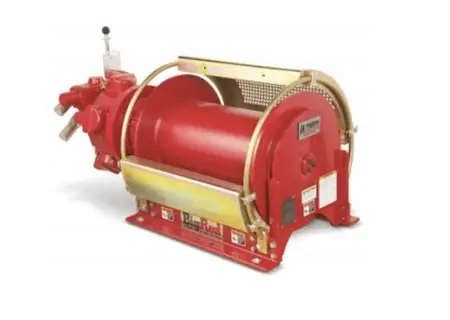
Air winch, also known as air hoist or tugger, serves like every other machine but with added features and functionalities.
How Does It Work?
An air hoist runs using compressed air instead of fuel or electricity. The intense pressure of air travels from the compressor to the machine’s motor, which sets the machine in motion to haul and pull loads.
This machine comes with an up and down regulatory panel, similar to a standard hoist, but with the added floating feature.
The compressed air pressure allows the floating functionality. This unique feature enables a weightless vertical movement.
Features
Since this machine does not require any extra power to work, it is viable for remote environment operations.
Moreover, it weighs 50% less than standard electrical hoists, so it is exceptionally suitable for jobs that require frequent location changes.
Another significant benefit is that it is not affected by high temperature, vapor, or humidity. Its self-cooling feature makes it the perfect device for time-constrained works.
Moreover, dirt and clouds of dust also do not affect the efficient performance of air hoists.
Besides, this machine is energy-efficient and environmentally friendly. With the same cost as other machines, you will get added advantages of not taking electric expenses and saving fuel.
Uses
Many oil and gas industries use this machine for performing risky jobs. Besides, it is also a popular choice for chemical industries too.
It is also perfect for rig installations, marine and shipping applications, and places that do not have modern technologies.
Maintenances
Air hoists are not easy to operate and require more profound knowledge and experience. Only trained, authorized operators should use this to minimize any risks.
Users should always wear safety gloves for better control and reducing risks. It is essential to check if the safety features of the machine are correctly working.
The safety features include an emergency stop, shock protection, and load brakes.
Moreover, chain boxes, brakes, and load hooks require an annual inspection to ensure better performance. It is vital to keep the chains properly lubed and check once a month.
Besides, for maximum efficient performance, users should operate at a 4 or 6 pressure. Also, the air pressure must be clean and dry for the machine to work correctly.
It is also crucial to consider that no other type of gas is suitable for an air hoist.
Lastly, it would help if you never used an air hoist in areas near corrosive materials. Avoid places near nuclear plants and organic acids.
Electronic Winch
Electrical winch run in two ways. They can directly draw power from a vehicle’s battery or come with its built-in battery that does not require any third party.
How Does It work?
These types of machines have a motor that rotates the drum to reel in the cable. When the device draws electricity from the external battery, it flows directly to the engine.
Moreover, the electric current converts on the opposite poles inside the motor; hence it causes the magnet to spin. The spinning magnet, in turn, gives power to the engine to revolve the spool drum.
People generally use electrical hoists for trucks and cars in the commercial industry, extracting timber in the forestry industry. They are also fit for use in the mining industry and agricultural industries.
Features
Since these machines usually run using the power from a third party, these are pretty easy to install.
There is no need for any extra equipment, and the operation is not complicated as well. All you have to do is plug it into your desired vehicle and start working.
Electrical winches are more efficient and faster than most standard devices. Moreover, these are also fit for carrying to different places.
The weight can vary, but most electrical hoists are light enough to be transported in your car to various locations.
One downside of these machines is that they are not fit for prolonged use. They tend to heat up quickly, so you may have to give breaks in between works. It might make your job lengthy and time-consuming.
Moreover, these machines are not suitable for very heavy-duty activities. These have a small driving force and cannot lift or pull massive equipment.
Wakeboard Winch
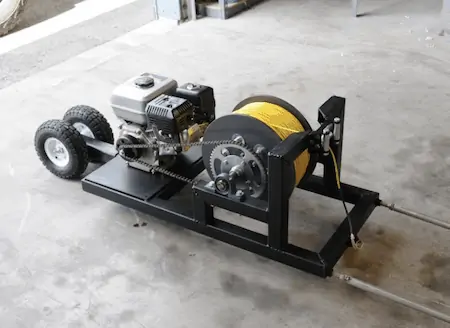
A wakeboard winch is a unique machine that is especially useful for a specific sport. Unlike others, this hauling device is helpful for pulling people, not loads.
The use of this device is especially limited to sports. People involved in water sports like wakeboarding are familiar with this machine. Besides, this unusual machine is also suitable for skating and skiing in the snow.
How Does It work?
A Wakeboard winch, also called a wake-skate hoist comprises an engine, tow rope, handles, and spool.
The tow rope or cable needs to be reeled around by walking or swimming to a specific distance to use a wake-skate machine.
Hence, When you turn on the device, the rope backs up and pulls the person over water on his board.
Features
Significant advantage riders can get from this machine is that it allows wakeboarding without a boat.
Hence, people involved in this type of sport can participate in the competition without buying a boat. Therefore, this machine gives them a cost-efficient way of participation.
Moreover, areas, where the water level is low, cannot support a motorboat. So, wakeboard hoists come handy for shallow water regions because it is lightweight.
But the use of a winch instead of a boat makes the setting up process lengthy.
In the case of speedboats, the rider usually floats in the water until the boat starts speeding up. But if the rider uses a walk-board hoist, it requires some additional setup.
It is necessary to secure the machine in place to avoid accidents. Furthermore, the tow rope should be spooled out enough for the rider to have a good grip.
Lever Winch
A lever winch is a high-quality portable machine that comes in handy for various lifting and pulling activities. This machine has the ability to haul and lift objects from every position, both vertically and horizontally.
How Does It work?
The working mechanism of this machine is pretty simple and effortless. Again, the hoist remains attached with a durable safety cap that holds the loads.
The handle also remains connected to a block that comes with an inner ratchet and a gear mechanism.
By rotating the lever, you can release or retract until you get your desired rope length. Then attach your object to the hook at the end of the lever.
To lift or drop the load, all you have to do is crank the handle up and down. Besides, you can customize the gearbox to facilitate easy movement of weights.
This machine is great for warehouses, garages, and construction sites. They are lightweight and can be moved from one place to another very quickly. However, these machines are not suitable for massive weight lifting.
Snubbing Winch
A snubbing hoist is pretty close to a traditional lifting machine, but the difference is it does not feature a lever or crank like other regular machines.
The spool of these types of machines usually takes a 90-degree angle. Manufacturers wrap the tow rope or line around the device.
You can reel it or tighten it as per requirement by pulling the tow rope. Once you stop drawing the line, the machine will take the load. The friction of the cable or rope allows you to control the release.
This device is mostly applicable for medium sailing boats. They use this machine to control the sheet line.
Maintenance of a Winch
Proper care of your machine for the best output is essential—every device, no matter how complex or straightforward its structure, requires time to time repair and maintenance.
Rope
You should always remember to inspect the tow line or cable wire before and after every use.
To avoid any unwanted hazard, checking the wire and replacing it is crucial. It is imperative to remove frayed or kinked ropes instantly.
Storage
Besides, you should always keep your machine away from any contamination. It is also essential to store the removable parts such as wires, hooks, or remotes in a safe place free from dirt and debris.
Before and after every use, you should clean your device with a rag to maintain performance efficiency.
After any heavy use, if you do not clean the crucial components, it might not give maximum output in your next service.
Servicing
If you own an electrical hoist, it is vital to keep it away from water. It would be best to take the machine to a licensed service center for any accidental water contact to get it fixed.
Besides, if you notice any weird performance issues but cannot put the finger on what is causing them, it is good to take it to the professionals to avoid accidents.
Battery
An extended period of use of electrical winches can adversely affect the battery of your vehicle.
It is essential to keep an eye on your battery’s health. Besides, hoists that work on in-build batteries also require time to time inspection.
Frequently Asked Questions
Do winches require a battery?
Only electrical winches require a battery to run. It depends either on an external battery or its in-built battery. The external battery may be your vehicle’s battery or a generator.
Other types of machines like hydraulic, manual, air, or lever hoist do not need extra power work. Those devices run on additional power like fuel power, air pressure, or human resources.
Are winches safe around water?
Hoists that work on electrical sources should not be in contact with water. Electrical winches can damage or cause accidents if they come in contact with water.
But, hydraulic, manual lever and other types of machines that do not have electrical components are suitable for use in the rainy season or around water.
Moreover, Hydraulic winch can function entirely submerged underwater. That is why it is a popular choice for marine industries
Which winch is suitable for light activities?
For light-duty jobs, a portable hand or lever hoist is most suitable. You can carry them in your vehicle without any trouble.
Moreover, the operation and installation of those machines are not complicated. Hence, a hand or lever winch is the best option for lightweight jobs.
Can anybody operate a winch?
With a basic knowledge and understanding, the operation of simple winches is straightforward. Anybody can work these machines and lift objects.
But for complicated machines like hydraulic and air hoists, you need training and experience before using.
Final Words
Hopefully, these insightful details of different types of winches helped you better understand these machines.
After reading this article, we hope you can find a suitable machine for your job if you are looking for one.
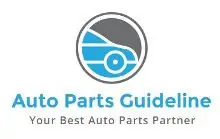

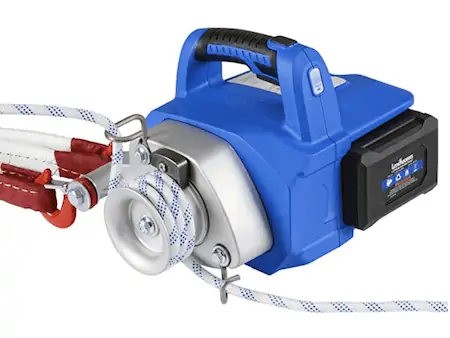
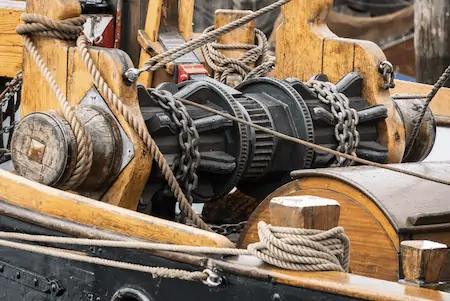

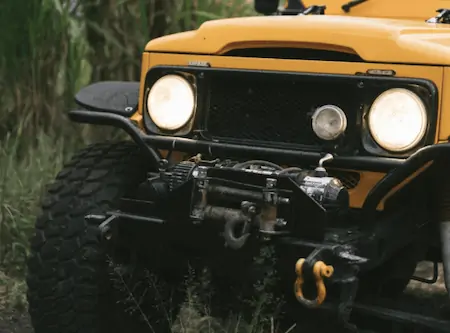
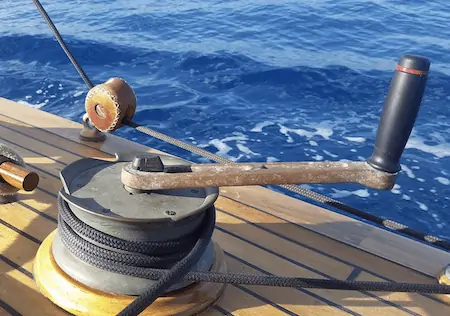

![Read more about the article Roller Fairleads vs. Hawse Fairleads [Guide for Beginners]](https://autopartsguideline.com/wp-content/uploads/2021/10/winch-fairleads-300x198.webp)
